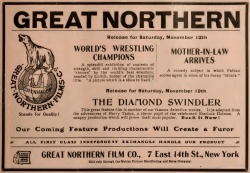The Diamond Swindler

The Diamond Swindler is a Danish silent movie released on 19 november 1910 (in USA), produced by Great Northern Film Co. Black & White.
The 1910 ads presented the movie as : This great feature film is another of our famous detective stories. It is adapted from the adventures of Harry Taxon, a clever pupil of the celebrated Sherlock Holmes. A snappy production which will prove itself most popular.
However some reviews in 1910 were describing the detective as Sherlock Holmes, see below.
Survival status: unknown.
Cast
- Harry Taxon : Franz Skondrup (?)
Plot summary
- The Moving Picture World, 19 november 1910, p. 1190-1191

THE DIAMOND SWINDLER. — A gentleman calls one day on the rich and young Count X, and tells him on discretion that he is obliged to dispose of a most precious necklace on account of momentary difficulties caused, by an unforeseen heavy loss of money. The necklace is very beautiful, and the count wants to buy it for his wife. The stranger advises the count to keep it until the following day and to inquire of a professional jeweler concerning its genuineness. The stranger takes his leave, and the count keeps the necklace, taking it at once to a jeweler, who pronounces it to be real without doubt, and most valuable. The stranger goes home, opens a safe, a door appears, and through this he goes to a cave, which has been made a workshop, and where several men are sitting making jewelry. The stranger takes out a necklace just like the one he gave the count, and the next day he goes to the house again, to inquire whether the count wants to keep it. But the count says that he does not want to pay so much as demanded, and the gentleman regrets very much, takes back the ornament and goes towards the door. He now quickly changes the two necklaces, and goes back once more, saying that he must dispose of the necklace and will take the amount offered by the count, as he is badly in want of money. In the evening the young countess wears her new beautiful necklace. It is very much admired, but a lady of her acquaintance who is a connoisseur on stones, examines it closely and declares her suspicion as to its genuineness. The countess is, of course, much perplexed, and they decide to take the necklace to the jeweler, who first examined it. But this jeweler declares it to be a different necklace and not real. They now go to Sherlock Holmes who can give only little hope, as he has no clue to the mystery. One day a distinguished looking gentleman calls on the lady who first suspected the falsification, asking her to buy some valuable jewels, on account of momentary difficulties. An appointment is made until the next day, and the lady at once informs Sherlock Holmes, who appears the next day and bides himself in the lady's room. At the moment when the swindler is going to change about the jewels, he is surprised and arrested. Sherlock Holmes, who is a master in disguising himself still more succeed in capturing the whole gang of swindlers at work at the secret workshop. The happy young countess receives at last the beautiful necklace which was intended for her.
Review
- The Moving Picture World, 3 december 1910, p. 1299

"The Diamond Swindler" (Great Northern). A snappy detective story in which Harry Traxton, a clever pupil of Sherlock Holmes, ferrets out a swindler and brings him to justice in a series of interesting scenes. The acting is excellent, and in common with other detective stories produced by this house this one holds the audience from the beginning to the end. The Great Northern people have an established reputation for detective stories and this picture will help in maintaining the reputation.